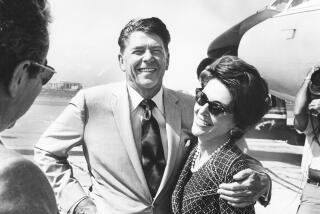10-Year-Old Prop.13 Debate to Be Recalled in State Exhibit
- Share via
SACRAMENTO — During his long career as a crusader against taxes, the late Howard Jarvis got an encouraging letter from British Prime Minister Margaret Thatcher and had his picture taken in the White House.
The Thatcher letter and the photo of Jarvis with President Reagan in the Oval Office go on display in the State Library in May.
Equal space will be devoted to Paul Gann, Jarvis’ partner in sponsoring Proposition 13, the 1978 initiative that rolled back California property taxes and sparked a nationwide tax rebellion.
The library has scheduled a six-week exhibit for the 10th anniversary of the historic initiative’s passage.
Both the Jarvis and Gann campaign organizations have given the library their political propaganda files for the 1978 tax election, along with personal souvenirs of the lives of both men.
That’s exciting for Gary Kurutz, the library’s director of special collections. He’s the “point man” for saving documents and pictures so future historians can trace the state’s development.
Jarvis died in August, 1986, at the age of 83. Gann, 76, still is active in California initiative campaigns. He announced last June that he had contracted AIDS as the result of a blood transfusion during heart surgery five years earlier.
Campaign Materials Saved
Groundwork for the exhibit was laid in mid-February when Kurutz drove to Southern California to pick up a pile of cardboard boxes of Proposition 13 campaign paraphernalia donated by Jarvis’ organization, the California Tax Reduction Movement.
On the same trip he received a collection of Jarvis’ personal letters, photographs and souvenirs from Jarvis’ widow, Estelle, and his sister, Dolores Tuttle.
“I guess what impressed me most was Jarvis’ sheer persistence,” Kurutz said. “He did this anti-tax thing for years and years on the local government level in Southern California, long before he ever became famous.”
Gann’s organization, People’s Advocate, earlier had donated Gann correspondence and memorabilia.
The Gann and Jarvis items currently are stored in the library’s basement, along with material from other landmark events in California history. Some of these, like the World War II internment of California Japanese, are things that happened decades ago but still are hotly debated.
The library already is collecting historic materials on the controversies of the 1980s.
One was the successful battle to deny voter confirmation to Chief Justice Rose Elizabeth Bird and two associate justices of the California Supreme Court in 1986.
Bird’s supporters have given the library a file of the campaign material they used in her behalf. The Jarvis organization opposed Bird. One of the 14 boxes in the Jarvis collection houses its file of anti-Bird propaganda.
The library also has gathered material used by both sides in the 1982 vote to repeal the Legislature’s enactment of the Peripheral Canal measure to channel northern water south, a turning point in the history of California water development.
Also stored in its building in Sacramento are documents on the Mediterranean fruit fly crisis that rocked the state in the early 1980s and damaged the political career of Democratic Edmund G. Brown Jr., governor at the time.
“I keep looking for things that are important and ought to be saved,” Kurutz said. “Some people donate materials to us out of a desire to preserve history. Others offer to sell them.”
“The State Archives preserves the documents generated by the government,” he explained. “We look for materials from other sources. We aren’t the only ones. The University of California in Berkeley and the Huntington Library in San Marino do a lot of this.”
The library’s interest does not stop at political issues. Relics of California’s economic and cultural history are welcomed.
Real Estate Brochures
Homefinder, a real estate magazine based in Irvine, donated a collection of brochures used by Southern California real estate firms in the post-World War II era, describing houses and listing their prices.
“It tells a lot about how people lived in Southern California then,” Kurutz said.
For fans of architecture, there is a file of 11,000 negatives of pictures taken by the Gladding, McBean Co., the longtime manufacturer of clay products. Tiles and ceramic decorations produced by the firm’s factory at Lincoln in Placer County still adorn buildings all over the West--including the State Library.
More to Read
Get the L.A. Times Politics newsletter
Deeply reported insights into legislation, politics and policy from Sacramento, Washington and beyond. In your inbox twice per week.
You may occasionally receive promotional content from the Los Angeles Times.










